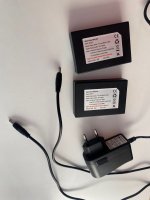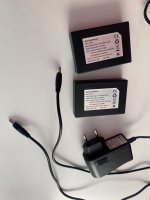hyperknot
100 µW
- Joined
- Oct 4, 2020
- Messages
- 9
I'm a paraglider pilot and I'm using electric heated gloves. The problem is that the gloves barely last 1.5 hours on the highest setting, so I'd like to build a longer lasting pack.
The original pack is 7.4V 2200 mAh LiPo. My idea is to make DIY 2S1P 21700 Li-Ion packs and use them in place. The load is very easy, max 2A, continuous, smooth load.
I'm thinking about using the new high-capacity LG-INR21700-M58T cells, or Samsung INR21700-50E. I think they are ideal for low current usage.
Some things are still not clear though:
- Do I need to use a BMS with balancing functionality or I can use a simple one, like those thin rectangular ones?
- Do I understand correctly that all BMS have a BM point for measuring the individual cell voltages, but only the more complicated ones balance the charging and discharging between the cells?
- Do I need to use a balanced charger like, a B6 Mini, and solder balancing cables? As I see it, balancing cables are not very common on Li-Ion packs, while everyone uses them for LiPo packs, right?
- Can I use the original CCCV charger? It has a Y cable so I believe it charges in parallel. It's very low current, 1.2A for both batteries in parallel, but I'm only planning to charge overnight.
- Do I need anything for building the pack, like those insulators and spacers? I bought a spot welder for this, so the welding should be straightforward, I just don't know about the rest, such as spacers, insulators, etc.
The original pack is 7.4V 2200 mAh LiPo. My idea is to make DIY 2S1P 21700 Li-Ion packs and use them in place. The load is very easy, max 2A, continuous, smooth load.
I'm thinking about using the new high-capacity LG-INR21700-M58T cells, or Samsung INR21700-50E. I think they are ideal for low current usage.
Some things are still not clear though:
- Do I need to use a BMS with balancing functionality or I can use a simple one, like those thin rectangular ones?
- Do I understand correctly that all BMS have a BM point for measuring the individual cell voltages, but only the more complicated ones balance the charging and discharging between the cells?
- Do I need to use a balanced charger like, a B6 Mini, and solder balancing cables? As I see it, balancing cables are not very common on Li-Ion packs, while everyone uses them for LiPo packs, right?
- Can I use the original CCCV charger? It has a Y cable so I believe it charges in parallel. It's very low current, 1.2A for both batteries in parallel, but I'm only planning to charge overnight.
- Do I need anything for building the pack, like those insulators and spacers? I bought a spot welder for this, so the welding should be straightforward, I just don't know about the rest, such as spacers, insulators, etc.
Attachments
Last edited:



